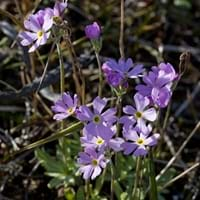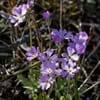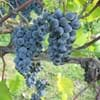Life Span
Perennial
Perennial
Type
Perennial
Bulb or Corm or Tuber
Origin
Northeastern United States, Mid-Atlantic United States, Southeastern United States, North-Central United States, Central United States, South-Central United States
South America
Types
Not Available
Pamianthe cardenasii , Pamianthe parviflora , Pamianthe peruviana
Number of Varieties
Not Available
Habitat
Roadsides, sand dunes, Waste areas
All sorts of environments
USDA Hardiness Zone
5-8
8-10
Sunset Zone
1a, 1b, 2a, 2b, 3a, 3b, 4, 5, 6, 7, 8, 9, 10, 11, 12, 13, 14, 15, 16, 17, 18, 19, 20, 21, 22, 23, 24
21,22
Habit
Clump-Forming
Clump-Forming
Flower Color
White, Ivory
White
Flower Color Modifier
Bicolor
Bicolor
Leaf Color in Spring
Green
Dark Green
Leaf Color in Summer
Green
Light Green
Leaf Color in Fall
Green
Several shades of Green
Leaf Color in Winter
Light Green
Light Green
Leaf Shape
Oblong
Strap shaped
Plant Season
Summer
Spring, Summer, Fall
Sunlight
Full Sun, Partial Sun
Partial Sun, Partial shade
Type of Soil
Loam, Sand
Loam, Sand
The pH of Soil
Acidic, Neutral, Alkaline
Acidic, Neutral, Alkaline
Soil Drainage
Well drained
Average
Bloom Time
Early Summer, Summer, Late Summer
Spring, Late Spring, Early Summer, Summer, Late Summer
Tolerances
Variety of soil types
Drought
Where to Plant?
Container, Ground, Pot
Ground, Pot
How to Plant?
Divison, Seedlings, Stem Planting
Offsets
Plant Maintenance
Low
Medium
Watering Requirements
Average Water Needs, Do Not over Water, Never Over-water, Requires regular watering, Water more in summer
Keep the ground moist but not water-logged
In Summer
Lots of watering
Lots of watering
In Spring
Moderate
Moderate
In Winter
Average Water
Average Water
Soil pH
Acidic, Neutral, Alkaline
Acidic, Neutral, Alkaline
Soil Type
Loam, Sand
Loam, Sand
Soil Drainage Capacity
Well drained
Average
Sun Exposure
Full Sun, Partial Sun
Partial Sun, Partial shade
Pruning
Remove damaged leaves, Remove dead branches, Remove dead leaves, Remove dead or diseased plant parts
Pinch or prune as they grow to promote branching and bushiness, Remove damaged leaves, Remove dead branches, Remove dead leaves, Requires little pruning
Fertilizers
All-Purpose Liquid Fertilizer, fertilize in growing season
All-Purpose Liquid Fertilizer, High phosphorus
Pests and Diseases
Slugs, Snails
Leaf spot, Mosaic viruses
Plant Tolerance
Variety of soil types
Drought
Flower Petal Number
Single
Single
Foliage Texture
Fine
Coarse
Foliage Sheen
Matte
Glossy
Attracts
Insects
Bees, Birds, Bumblebees, Butterflies, Hummingbirds, pollinators
Allergy
Abdominal pain, Constipation, Diarrhea, Skin irritation
Unknown
Aesthetic Uses
Beautification, Borders, Landscape Designing, Showy Purposes
Beautification, Bouquets, Ornamental use, Showy Purposes
Beauty Benefits
Good for skin, Making cosmetics, Stops hair loss
No Beauty Benefits
Environmental Uses
Air purification, Food for insects, Versatility
Air purification
Medicinal Uses
Eczema
No Medicinal Use
Part of Plant Used
Root
Not Available
Other Uses
Decoration Purposes, Medicinal oil, Showy Purposes, Used as Ornamental plant, Used for its medicinal properties
Beneficial species for attracting pollinators, Decoration Purposes
Used As Indoor Plant
Yes
No
Used As Outdoor Plant
Yes
Yes
Garden Design
Edging, Feature Plant, Groundcover, Mixed Border
Bog Garden, Container, Feature Plant, Foundation, Mixed Border, Water Gardens
Botanical Name
Primula mistassinica
HYMENOCALLIS longipetala
Common Name
Mistassini primrose, Lake Mistassini primrose, bird's-eye primrose
Peruvian Daffodil, Spiderlily
In Hindi
Mistassini Primrose
peruvian daffodil
In German
Mistassini Primrose
peruvian daffodil
In French
Primrose Mistassini
peruvian daffodil
In Spanish
Mistassini Primrose
Pamianthe
In Greek
Mistassini Primrose
peruvian daffodil
In Portuguese
Mistassini Primrose
peruvian daffodil
In Polish
Mistassini Primrose
peruvian daffodil
In Latin
Mistassini Primrose
peruvian daffodil
Phylum
Magnoliophyta
Magnoliophyta
Class
Magnoliopsida
Liliopsida
Order
Myrtales
Asparagales
Family
Onagraceae
Amaryllidaceae
Genus
Oenothera
Pamianthe
Clade
Angiosperms, Eudicots, Rosids
Angiosperms, Monocots
Tribe
Onagreae
Clinantheae
Subfamily
Onagroideae
Amaryllidoideae
Number of Species
Not Available
Season and Care of Mistassini Primrose and Peruvian Daffodil
Season and care of Mistassini Primrose and Peruvian Daffodil is important to know. While considering everything about Mistassini Primrose and Peruvian Daffodil Care, growing season is an essential factor. Mistassini Primrose season is Summer and Peruvian Daffodil season is Summer. The type of soil for Mistassini Primrose is Loam, Sand and for Peruvian Daffodil is Loam, Sand while the PH of soil for Mistassini Primrose is Acidic, Neutral, Alkaline and for Peruvian Daffodil is Acidic, Neutral, Alkaline.
Mistassini Primrose and Peruvian Daffodil Physical Information
Mistassini Primrose and Peruvian Daffodil physical information is very important for comparison. Mistassini Primrose height is 610.00 cm and width 460.00 cm whereas Peruvian Daffodil height is 61.00 cm and width 61.00 cm. The color specification of Mistassini Primrose and Peruvian Daffodil are as follows:
Mistassini Primrose flower color: White and Ivory
Mistassini Primrose leaf color: Green
Peruvian Daffodil flower color: White
- Peruvian Daffodil leaf color: Dark Green
Care of Mistassini Primrose and Peruvian Daffodil
Care of Mistassini Primrose and Peruvian Daffodil include pruning, fertilizers, watering etc. Mistassini Primrose pruning is done Remove damaged leaves, Remove dead branches, Remove dead leaves and Remove dead or diseased plant parts and Peruvian Daffodil pruning is done Pinch or prune as they grow to promote branching and bushiness, Remove damaged leaves, Remove dead branches, Remove dead leaves and Requires little pruning. In summer Mistassini Primrose needs Lots of watering and in winter, it needs Average Water. Whereas, in summer Peruvian Daffodil needs Lots of watering and in winter, it needs Average Water.





